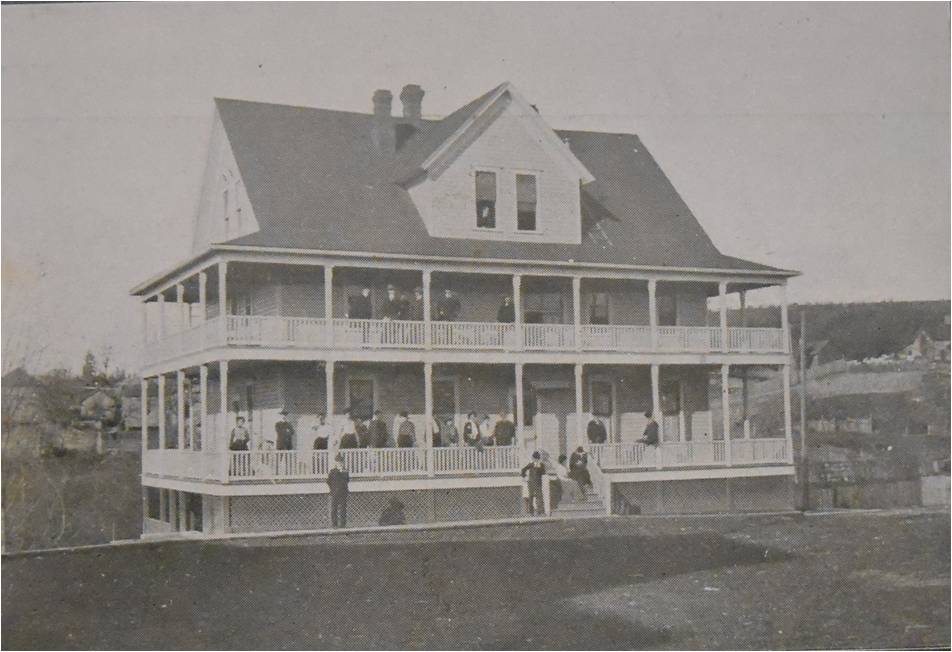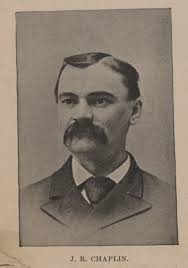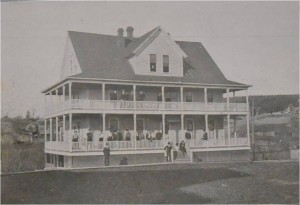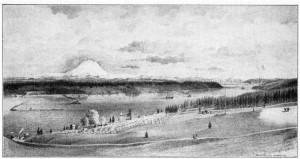
By Drew Crooks
 Higher education has long been important in Olympia. One of the most interesting colleges that existed in the capital city was the People’s University of the early 20th century. Some have considered this school to be a precursor to The Evergreen State College in Olympia.
Higher education has long been important in Olympia. One of the most interesting colleges that existed in the capital city was the People’s University of the early 20th century. Some have considered this school to be a precursor to The Evergreen State College in Olympia.
The story of the People’s University is interwoven with the life of John Riley Chaplin, an idealist who believed that education was the key to a better society. Born on April 30, 1851 in Fowlerville, Michigan, he married Emma Strobridge in 1875. They both attended Adrian College. The couple would have six children: Frank, Emery, Grace, Gurnsey, Ethel, and Winthrop.

John Chaplin became an ordained minister in Michigan, first for the Methodist Protestant Church, then for the Congregational Church. 1889 proved to be a turning point for the Chaplin family. They came west to Olympia that year just as Washington moved from territory to statehood. For a brief time John Chaplin served as the minister of the Congregational Church in Olympia. In 1890 he resigned from his post and got involved in real estate and educational matters.
This dreamer platted the community of College Grove in 1891 on Cooper Point which would feature a college named Olympic University. Development on Cooper Point, however, made little progress, especially with a nationwide economic downturn in 1893. Still on September 18, 1894 the Olympic University opened in “temporary” quarters in the old Collegiate Institute buildings (located on what is now Olympia Avenue near East Bay Drive). The fledgling school operated for one academic year, but did not reopen in the fall of 1895. Both Olympic University and College Grove faded away.
The determined John Chaplin did not give up on his ideas. In 1900 he announced plans for the People’s University which would be associated with a new community called Athens. Both would again be situated on Cooper Point. Chaplin dreamed that Athens would be a place without alcohol, public gambling, and prostitution. His vision for the People’s University was also highly moralistic.
John Chaplin wanted his college, as stated in the school’s College Independent magazine, to be an institution “of the people and for the people and will be governed as much as possible by the people.” No economic, religious, or political group would control its operations. The visionary saw the People’s University as a place where academic and practical methods, including a department of travel, would produce moral individuals who would create a better society.
Until poor health slowed him down, Chaplin energetically pushed for the People’s University locally, regionally, and nationally. He traveled numerous times across the nation in search of funding and students. At the same time John Chaplin promoted land sales for his Olympia Development Company. Indeed, many people immigrated to Olympia because of his salesmanship.

The People’s University, like its Olympic University predecessor, opened in “temporary” quarters in the old Collegiate Institute buildings (near present-day East Bay Drive) on September 16, 1902. Classes were wide ranging with degrees offered in philosophical, literary and collegiate subjects, and courses in commercial, normal (teaching), and music fields. There would even be evening classes for those who worked full time.
Costs for the students seem amazingly low by today’s standards. A Morning Olympian newspaper article dated August 15, 1902 outlined the preparatory and collegiate departments’ tuition rates: “per term of twelve weeks, $10; incidentals, per term of twelve weeks, $5; incidentals per term of thirty-six weeks, $10.”
The same article listed room and board costs for students: “Unfurnished rooms will cost, per term, $5; furnished rooms, lighted and heated, per term, $12; when two students occupy the same room, $18. Board per term, good, substantial and abundant, $35; furnished room and board, per term, $42.”
Despite hopeful talk, the People’s University never left its “temporary” quarters and did not move to Cooper Point. The Athens community also did not grow on the Point. Still, as indicated in the university’s magazine (first College Independent, then Western Independent) and contemporary local newspaper articles, the school existed for four academic years (1902-1906) with college classes and activities. Music especially seemed important at the People’s University, a fact made apparent at its annual musicale and students’ recital.

John Chaplin constantly fought for his university. Then in 1905 his health seriously deteriorated from a liver disease. He had to step back from active participation in the school’s operations. The People’s University held its graduation in June 1906, but it was faltering. Emery Chaplin, son of John, purchased the school in July. It did not reopen in the fall.
The dreamer John Chaplin died on October 22, 1906 and was buried in Tumwater’s Masonic Memorial Park. For a time the People’s University facilities were temporarily used for Olympia High School classes. They were sold in January 1907 to the Evangelical Lutheran Synod for use as a seminary that lasted for a number of years. In the 1920s the well-used structures were demolished.
Some historians have regarded the People’s University as a precursor to The Evergreen State College because of its progressive ideas and intended location on Cooper Point where the modern school is situated. Still the People’s University was definitely a product of its times and the vision of John Chaplin. Perhaps the real importance of the school is that it existed for four years and directly impacted the lives of its students, teachers, and the Olympia community.
Acknowledgments: The historical resources at the Washington State Library proved essential to the writing of this article. It is a wonderful place to learn about our local and state history.
















































